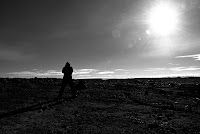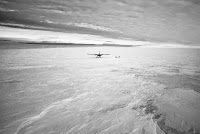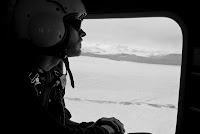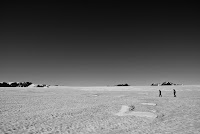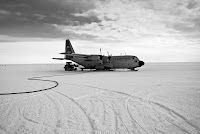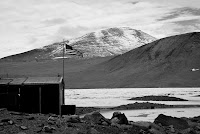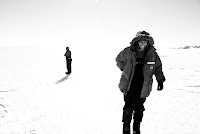It's been a few weeks since the last post. I never did get to Mt. Paterson, but I eventually got out to WAIS Divide (after 5 days of cancelations - not nearly as bad as the 2.5 weeks endured by the rest of my crew). We had a very productive time there, visiting all but one of the sites we needed to service. There was a pretty big POLENET crew out there because we had to do
a lot of digging.
Because our seismic sites measure activity in the ice, they are buried in snow at many locations. Some of these locations are on glaciers with very high rates of snow accumulation (up to 6 or 7 feet per year). When the stations are installed, the sensors are buried just below the surface, encased by a large dome to protect them from drifting snow. Each year, when the sites are visited, the sensors are dug out and repositioned just below the surface again. Even one year's accumulation takes a lot of work to dig up. The four glacier sites we serviced from WAIS hadn't been visited in two.
 |
| The remnants of the 10-12' hole we dug at Lower Thwaites Glacier. That's a pretty large collapsed cardboard box on the right. |
 |
| Our seismic engineer, Doug (who's pretty tall), stands in the ~14' hole out of which we dug the seismic sensor at Kohler glacier. |
I also got a chance to visit a GPS site to which I'd never been before: Bear Peninsula. While I didn't actually go to the site (it required traversing quite a lot of steep blue ice and there was only enough mountaineering equipment for the mountaineer and the engineer), I did get to sit high up on the peninsula and watch them work from afar. We could see open water far in the distance and the sun appeared and disappeared over the mountains in the other direction. We explored the extensive striated serpentine deposits and talked geology with the pilots as we waited for the engineer and mountaineer to service what turned out to be a mildly exploded station.
 |
| Doug (far away, center) and Brian (right) take pictures under a colorful sky at Bear Peninsula. |
 |
| Dave, our logistical coordinator and my officemate back in Columbus, attempts to knee-sled down the slippery blue ice at Bear Peninsula on the way back to the plane. It wasn't very successful. |
WAIS life was very similar to the way I remembered it - friendly people, camping on the ice sheet, skiing, the occasional soccer match, whiling away the non-work hours with card games, conversation (there's no internet), games devised from our unused scientific equipment (e.g. spin the person in the seismic dome!), and side projects for whoever needed an extra hand, like a back-lit ice pit (two pits dug in the snow, one covered, with a thin wall in between that allows daylight to illuminate it and show layers in the ice - see below; we went a little overboard, building steps, chairs, wine coolers, and food prep/storage space). At its height, the population of the camp was 41, but that didn't last long, as that was while people from smaller camps and traverses were passing through just to catch a flight back to McMurdo for the end of the season. I was out there for two weeks and got out on the first try (pretty unusual). Now I'm back in McMurdo until mid-February doing helicopter and fixed-wing work near the coast.
 |
| The back-lit ice pit wall from the spectator side. The spot where the wall was a little too thin and we broke through was patched and eventually food-colored to look like stained glass. The wall is about 6 feet high and reveals almost two years of accumulation. |
 |
| Erin, the primary proponent of the ice pit, sits in the recessed chair next to the stairs descending into the pit. |
 |
| Dave is spun in a spare seismic sensor protective dome by Brian, Doug, and Maeva, in front of the POLENET work tent at WAIS while other members of the project look on. |
I'm getting back into the swing of 'town' life - hanging out at the lounges/bars, playing indoor soccer once or twice a week, hiking on a semi-regular basis, and keeping track of goings-on via e-mail. Meanwhile, after a slow start, we've been productive via helo and fixed-wing flights. Last week we got to one site and this week we're at three so far, with more in the pipeline. It helps that most of the science projects are in the process of packing up and leaving, so we have the plane almost entirely to ourselves and the helicopter schedule is, at the very least, uncrowded. We also have enough people (8) that we can run two crews/day. For example, yesterday (Tuesday), four of us went to a helicopter site near the northern coast of the Transantarctic Mountains called Brimstone Peak, while three went to a fixed-wing site in the opposite direction called Deverall Island.
Brimstone Peak is a beautiful site - to get there, we fly across the Ross Sea from Ross Island to Marble Point, where we fuel, and then up the spine of the Transantarctic Mountains (TAM). Brimstone Peak, at 7,677 ft, stands almost alone amidst the sea of ice that slowly takes over as the TAM diminish into East Antarctica in Northern Victoria Land. The peak is comprised of monumental columnar basalts formed from Jurassic Kirkpatrick Basalt flows, which are part of the Ferrar Group and the Beacon Supergroup, all of which are associated with the rifting of West Antarctica and the breakup of Pangaea. It's named for its brimstone-colored rock.
 |
| Spencer, Brian, and Cristo work on the electronics of the GPS station at Brimstone Peak. The GPS antenna is in the foreground. |
 |
| A panorama looking west from Brimstone Peak toward the East Antarctic Ice Sheet. On the next ridge over, the Beacon Group sediments underlying the Kirkpatrick Basalts are visible. |
On the way back from Brimstone Peak, we stopped to pick up cargo at Lake Hoare, at the foot of the Canada Glacier, in the Dry Valleys. The cargo displaced us somewhat, so we were a bit squished in the back of the helicopter, but it was well worth it. The Dry Valleys were beautiful and, despite their proximity to McMurdo and the number of my associates who work there, I had never been. The lake itself, which is hypersaline and contains liquid water throughout the year (and therefore plays host to some unusual biota), is a very popular research spot and has a semi-permanent camp, complete with wooden structures and internet.
 |
| The camp at Lake Hoare, with a couple of tents against the Canada Glacier in the background. |
That's all for now. We'll continue waking up before 6 every morning hoping to fly, but we don't have very many sites left - we might even get out of here early! I'll be publishing a post soon that's entirely dedicated to pictures, so keep an eye out if that's your cup of tea! As always, thanks for reading!
